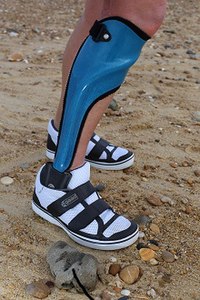
Photo from wikipedia
BACKGROUND During gait, the human ankle both bends with ease and provides push-off forces that facilitate forward motion. The ankle is crucial for support, stabilization, and adapting to different slopes… Click to show full abstract
BACKGROUND During gait, the human ankle both bends with ease and provides push-off forces that facilitate forward motion. The ankle is crucial for support, stabilization, and adapting to different slopes and terrains. Individuals with lower limb amputation require an ankle-foot prosthesis for basic mobility. METHODS Inspired by the role of the ankle-foot in an able-bodied gait, the 3D printed Compliant and Articulating Prosthetic Ankle (CAPA) foot was designed. It consists of four articulating components connected by torsion springs and produces forces that are dependent on the ankle angle. Using the Computer Assisted Rehabilitation Environment, able-bodied individuals walked wearing a prosthetic simulator with the Solid Ankle Cushioned Heel foot, Renegade® AT, and multiple versions of the CAPA. These versions test compliant vs. stiff, small vs. large rocker radius, and pretension vs. none. We hypothesized that the CAPA would have larger ankle range of motion, push-off forces, and braking forces. FINDINGS Compared to existing prostheses, the novel prosthesis exhibits greater and significantly different ankle range of motion and sagittal plane ground reaction forces than existing prostheses during gait. Nine out of ten individuals prefer the novel prosthesis to the existing prostheses, and there is a statistically significant difference in difficulty level ratings. INTERPRETATION By providing a personalizable and passive alternative to existing designs, the CAPA could improve the quality of life for the growing number of individuals living with limb loss in the United States and around the world.
Journal Title: Clinical biomechanics
Year Published: 2019
Link to full text (if available)
Share on Social Media: Sign Up to like & get
recommendations!